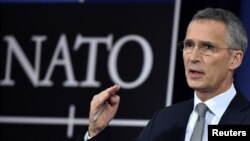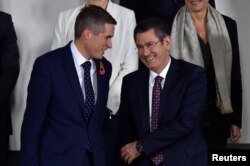Wary of a belligerent and unpredictable Russia, NATO is expanding its operations for the first time since the end of the Cold War and drawing up plans to improve the way the military alliance commands and deploys its forces.
NATO defense ministers Wednesday endorsed a proposal to create two new commands: one to protect sea lanes ferrying troops and equipment across the Atlantic from the United States, the other a logistics command to supervise troop movements in Europe.
"We need a command structure which can make sure that we have the right forces, in the right place, with the right equipment at the right time," NATO Secretary-General Jens Stoltenberg told reporters at the meeting in Brussels.
He said the Atlantic headquarters would "ensure that sea lanes, our lines of communication between Europe and North America, remain free and secure. This is vital for our trans-Atlantic alliance."
"Our military commands will now flesh out the details," Stoltenberg said, and submit the results to the ministers when they next meet in February.
No Russian risk seen
Asked about the risk that Russia poses to the 29-nation alliance, particularly those lying on Russia's borders, Stoltenberg said "we don't see any imminent threat against any NATO ally."
But, he said, "we have seen a much more assertive Russia. We have seen a Russia which has over many years invested heavily in their military capabilities, modernized their military capabilities."
Russia has shown itself "willing to use military force against a neighbor, Ukraine, and of course NATO has to be able to respond to that," he added.
At the end of the Cold War almost 30 years ago, around 22,000 personnel were working at 33 commands, but numbers have been slashed to fewer than 7,000 people and seven commands.
NATO allies have stationed around 4,000 troops in the Baltic States — Estonia, Latvia and Lithuania — and Poland to reassure them that the alliance stands ready to defend their borders against neighboring Russia. The move came in response to Russia's annexation of Ukraine's Crimean Peninsula in 2014.
Command locations
Stoltenberg has been coy about where the new regional command centers would be based — he says the plan will be fleshed out in February — but he has noted Germany's central geographical location in Europe, suggesting that it could be in the running for one. Poland is another possibility.
Britain, Portugal, Spain or even the United States might be considered for the Atlantic command.
One key factor holding up troop movements in Europe is border controls between the various nations.
Russia has few border obstacles to contend with and can deploy its forces virtually at will. NATO commanders are appealing for red tape to be cut. Officers have said that transit and transport requests need to be submitted up to 30 days in advance in some cases.
Stoltenberg said the allies have also agreed to work more closely with the European Union to improve civilian infrastructure like bridges, roads, railways, airport runways and ports so they can handle heavy military equipment.
They also want to work more closely with private companies to ensure that NATO has the kinds of transport it requires — trucks, trains and planes — to deploy more easily.









